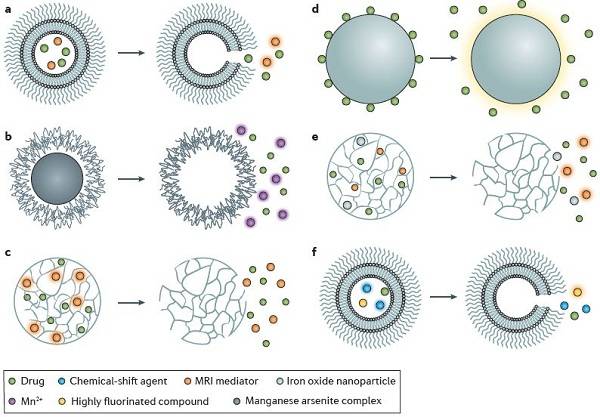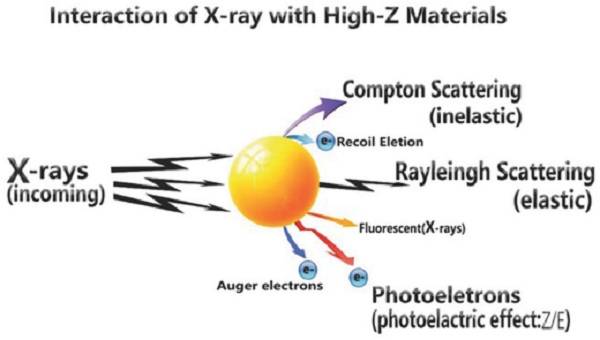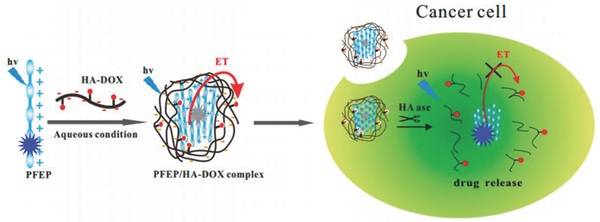1. Nat. Rev. Mater. Review: Rethinking Cancer Nanotechnology

Figure 1 Nanomedicine preparation for monitoring drug release
Professor Chen Xiaoyuan (corresponding author) of the National Institutes of Health and Xie Jin (communication author) of the University of Georgia published a review article entitled "Rethinking cancer nanotheranostics" in the famous journal Nature Reviews Materials. This review describes the basic principles of cancer nanomedicine technology and the development of cancer nanomedicine. They also focused on the impact of new methods on clinical applications, including stratifying patients to differentiate subgroups benefiting from nanotherapy; tracking drug release and infiltration of tumors; imaging-guided focused therapy and detection of treatment feedback . In addition, the article also lists the opportunities and challenges of nanomedicine, including the comprehensive characterization of individual tumors; understanding and predicting the interaction of nanoparticles with tumors and designing nanomedicine to optimize treatment options.
2. Chem. Rev. Overview: Chemical Design and Synthesis of Functionalized Probes for Imaging and Treatment of Tumor Hypoxia

Figure 2 Schematic diagram of tumor hypoxia imaging and treatment
Researcher Shi Jianlin and Assistant Professor Liu Jianan from the Shanghai Institute of Silicate and Professor Zhang Wenbo from the Shanghai Institute of Silicate and Professor of East China Normal University (Communication Newsletter) summarized the reports on the imaging and treatment of hypoxic tumors. First, in the order of fluorescence imaging, positron emission tomography, magnetic resonance imaging, and photoacoustic imaging, the article introduces the design concept of various hypoxic reaction probes that can be applied non-invasively to image hypoxia. The latest functional nanomaterials that can be used to effectively treat tumor hypoxia are summarized. Finally, the challenges and future prospects of researchers in this field are discussed. The above content was published in Chemical Reviews under the title "Chemical Design and Synthesis of Functionalized Probes for Imaging and Treating Tumor Hypoxia".
3. Adv. Mater. Overview: New nanotechnology and advanced materials for cancer radiotherapy

Figure 3 Interaction between X-ray and high Z element material nanoparticles
Radiation-absorbing nanomaterials can be used as radiosensitizers to deposit radiant energy within a tumor and to promote therapeutic efficacy. Nanocarriers are capable of delivering therapeutic radioisotopes to tumors of internal RIT or chemotherapeutic drugs that cooperate with chemical radiotherapy to modulate the tumor microenvironment through various nanomedical methods to overcome the radiation tolerance associated with hypoxia. Recently, Liu Zhuang Research Group of Suzhou University published the latest review on Advanced Materials: Emerging Nanotechnology and Advanced Materials for Cancer Radiation Therapy. Summarized the application of nanomedicine in the treatment of RT cancer, and paid special attention to the latest development of cancer RT advanced materials.
4. Adv. Mater. Overview: Stimulation-driven transformational diagnostic preparations for cancer-related multimodal imaging and treatment

Figure 4 Hyaluronic acid-driven transformation diagnostic preparation
Advances in bioinformatics, genomics, proteomics, and metabolomics have led to the development of new anticancer drugs. Therapeutic system combines the diagnosis and treatment systematically, and has received much attention for its excellent performance in precision treatment. Therefore, Professor Chen Xiaoyuan (communication author) of the National Institutes of Health and Professor Juyoung Yoon (communication author) of Ewha Womans University in Korea published a book entitled "Cancer-Associated, Stimuli-Driven," in the famous materials journal Advanced Materials. A review article by Turn on Theranostics for Multimodality Imaging and Therapy. This review focuses on the application of stimuli response in diagnosis and treatment. It not only describes the basic principles of diagnosis and treatment applied to drugs, but also discusses the methods of stimulating response to drug conversion.
Dried Ginger Yunnan Origin,Dried Ginger Whole,Air Dried Ginger,Yunnan Origin Of Dried Ginger
Weishan Yuanxing Walnuts Co.,Ltd. , https://www.walnutsxxy.com